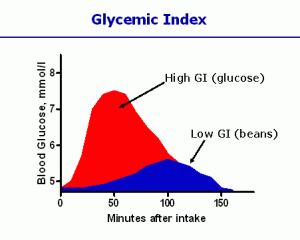 The Glycemic Index – What is it: Medicinenet.com describes the Glycemic Index as, “An indicator of the ability of different types of foods that contain carbohydrate to raise the blood glucose levels within 2 hours. Foods containing carbohydrates that break down most quickly during digestion have the highest glycemic index.”
The Glycemic Index – What is it: Medicinenet.com describes the Glycemic Index as, “An indicator of the ability of different types of foods that contain carbohydrate to raise the blood glucose levels within 2 hours. Foods containing carbohydrates that break down most quickly during digestion have the highest glycemic index.”
When food breakdown quickly they can introduce spikes in blood sugar within the body of diabetics. If a diabetic can learn to find foods with a low GI they will likely see a more manageable glucose level in the long-term.
Knowing this information can actually help in cases where significant exercise may require an energy boost. For instance the use of a high GI food item can provide a boost of energy that the individual may need. However, in most cases the lower the Glycemic Index the better.
A Few of the Best Choices
Wikipedia suggests a few of the following foods for low GI levels – “Most fruit and vegetables (except potatoes, watermelon), grainy breads, pasta, legumes/pulses, milk, products extremely low in carbohydrates (fish, eggs, meat, nuts, oils).”
More Specific Help
GlycemicIndex.com provides a searchable database to help you find the GI for most common foods you may choose to eat as part of your diet.
It may come as a surprise, but it appears pasta may not be a bad food item after all. GlycemicIndex.com reports, “Pasta has a low GI because of the physical entrapment of ungelatinised starch granules in a sponge-like network of protein (gluten) molecules in the pasta dough. Pasta is unique in this regard. As a result, pastas of any shape and size have a fairly low GI (30 to 60).”
GI – Not Just for Diabetics
Many athletes are learning to choose their food carefully to allow a slow release of blood sugar to provide greater endurance and energy. The use of GI information for this purpose should help show diabetics that there are compelling reasons for attention to the foods they eat.
There are also many diets such as South Beach and NutriSystem that use the Glycemic Index to help them develop a weight loss plan for their clients.
Always a Critic
There are some that suggest the GI is flawed to a greater or lesser degree because it doesn’t always take into account the way the food is prepared, the insulin resistance of the individual or a meal that has multiple foods. Certain combinations of food can either raise or lower the GI to levels that may not be suggested by strict adherence to the GI tables.
Like many things in life the Glycemic Index was designed to simply provide some direction in the foods an individual may choose to eat. It remains very important to consult with your doctor and/or nutritionist to maintain the best course of managed care for your diabetes.
The Other Side
Proponents will argue that the GI provides two levels of effectiveness. The first is to help diabetics understand what foods may cause a sharp and sudden burst in blood sugar levels. The second is that attention to the Glycemic Index can help users lose weight. By losing weight they will typically see a more stable blood sugar level and may require fewer meds. They may find they have the energy to exercise more as well. In combination these things are a help to the diabetic.
That being said it is still in your best interest to discuss managed care options with your physician.